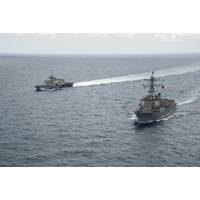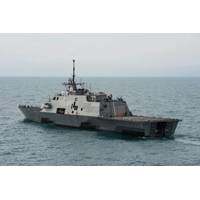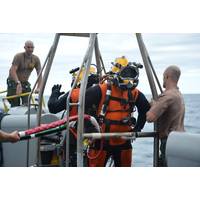Navy Surveys North Sea for Links to the Toughness of its Past
A multinational group of Sailors and scientists from a variety commands, organizations and militaries searched for the wreckage of Revolutionary War ship Bonhomme Richard, Sept. 2-9. Underwater archaeologists from the Naval History and Heritage Command (NHHC), Navy divers from Mobile Diving and Salvage Unit(MDSU) 2, Sailors from Naval Oceanography Mine Warfare Center (NOMWC), Sailors from the French Mine Clearance Dive Unit (MCDU) and members from Global Foundation for Ocean Exploration (GFOE) embarked upon Military Sealift Command rescue and salvage ship USNS Grasp (T-ARS 51) to survey

US Navy Ships Exit AirAsia Search
effort, and our sailors are proud to have been able to assist." Working in coordination with the Government of Indonesia, the U.S. 7th Fleet tasked Littoral Combat Ship USS Fort Worth to join in the search effort. After loading supplies and embarking an eight-member team from Mobile Diving and Salvage Unit (MDSU) 1, Fort Worth departed Singapore January 2 and arrived on station January 3. USS Fort Worth brought maneuverability, speed and shallow draft to the search, allowing her 100-person crew to conduct expeditious visual and radar searches in a congested, shallow water environment. Her

US Navy Using Advanced Equipment in AirAsia Search
An eight-member team from Mobile Diving and Salvage Unit (MDSU) 1 onboard USS Fort Worth (LCS 3) is supporting the ongoing Indonesian-led search effort for AirAsia flight QZ8501 with advanced Tow Fish side scan sonar systems capable of providing high-resolution images of the ocean floor. The Tow Fish side scan sonar system is used to identify objects on the seafloor and provide accurate imagery for analysis. The sonar carries a passive listening device for detecting an acoustic pulse and is towed behind a vessel between 1-5 knots. The acoustic signal is then transmitted to a computer where

Navy Divers Salvage F-16C Aircraft From GofM
Navy sailors and divers from Mobile Diving and Salvage Unit (MDSU) 2, embarked aboard the Navy's rescue and salvage ship 'USNS Grasp' (T-ARS-51), find and salvage a downed F-16 aircraft off the coast of Virginia. The downed aircraft was one of two F-16 fighter jets from the 113th Wing, D.C. Air National Guard that clipped wings mid-air during a routine training mission 35 miles southeast of Chincoteague, Va., on 1, August 2013. The other aircraft involved in the incident was able to fly back to Joint Base Andrews in Md. without further incident. Staging out of Chincoteague Island, Va., the team of


 February 2024
February 2024





